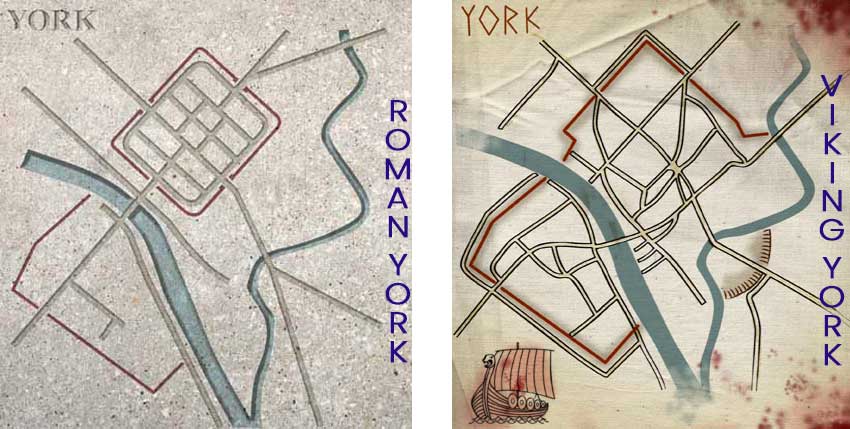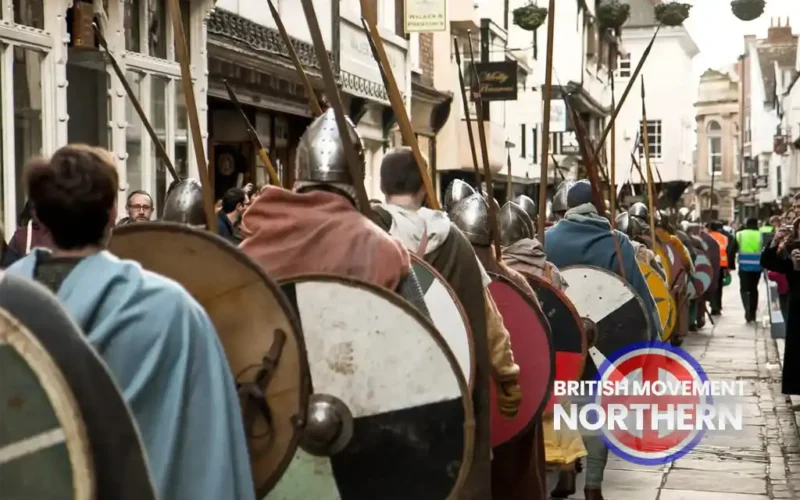At present the Jorvik Viking Festival is in full swing in the famous Northern city of York, with living history camps, workshops, guided tours, traditional crafts, feasts, family-friendly activities, evening shows, and combat displays.
Running from February 17th to 23rd, York transforms into a hub of Viking culture with the annual festival, now in its 40th year. As has become something of a local tradition, many British Movement members will be attending the festival to savour the authentic sights and sounds of our Scandinavian ancestors.
Saturday, February 22, marks the highlight of the festival with the March to Coppergate, featuring a parade of over 200 Vikings through York’s historic streets. The festivities will culminate at the Eye of York with the Viking Games, where rival warriors will face off in battle.
The festival is well worth a visit, as is the city itself. York is within easy reach of Leeds and Manchester and, after London, is probably one of the best-preserved historic cities in Britain.
A Brief History of York
In the initial five years after the conquest of Britain in AD 43, the Roman legions progressed gradually from their administrative and economic hub, London. This slow advancement marked a significant phase in the establishment of Roman control over the region, as the armies expanded their influence beyond the capital.
The Romans dedicated the next 30 years to subduing the ‘barbarians’ inhabiting northern England and Scotland. To safeguard their rear, the legions stationed in Lincoln, Wroxeter, and Gloucester were repositioned to York, Chester, and Caerleon, establishing these locations as the practical boundaries of the ‘civil zone.’
The indigenous Brigantes tribes, who predominantly inhabited the region now known as Yorkshire, fell under the dominion of the legionary fortress at Eboracum. In AD 71, the renowned Ninth Roman Legion established its presence in this area.

On November 1, 866, the Viking invaders, led by Halfdan and Ivar the Boneless, attacked Eoforwic (York). The timing of this attack appears to have been deliberate, coinciding with All Saints Day, a significant celebration in York. This occasion likely drew many of the town’s leaders to the cathedral, thereby enhancing the element of surprise for the invaders.
The strategy proved successful, as the Vikings managed to seize control of York. However, the Northumbrian monarchs, Aelle and Osbert, were not apprehended during this incursion. Eoforwic had become Jorvik.
Two years later, King Alfred of Wessex reached an agreement for a truce with Viking king Guthrum, resulting in the division of England into the Anglo-Saxon southern kingdom and the Danelaw.
The Danelaw, governed by the Vikings, encompassed regions situated north of an imaginary boundary extending from London to Bedford and then northward to Chester. This marked the first significant north-south divide in England. It was later written that the area quickly evolved into the capital of a kingdom that shared its name, which approximately aligns with the present-day region of Yorkshire.
By the year 1000 AD, York had experienced significant growth, boasting a population of approximately 8,000 residents. This expansion reflected the city’s increasing importance and influence during the Viking Age.
The famous battle at Stamford Bridge in 1066, between Harald Hardrada and Harold Godwinson (the last Anglo-Saxon king of England), marked the decline of the Vikings, and the end of the Viking era. King Harold was defeated only days later by William of Normandy at the Battle of Hastings.
The Norman invasion significantly transformed York, leading to the establishment of the city as it exists in contemporary times. This pivotal event marked a turning point in the city’s development and architectural landscape.
Credits:
Main Image: Viking warriors march through the streets of York.
Lower Map Images: With thanks to York Museums Trust.
Video: YouTube.
The British Movement welcomes articles for possible inclusion on this site from members and supporters across the North of England. Please remember that we have to operate within the laws of this country; we will not include any content that is against the current laws of the United Kingdom. News reports should be topical and relevant to the regions covered by this website.












